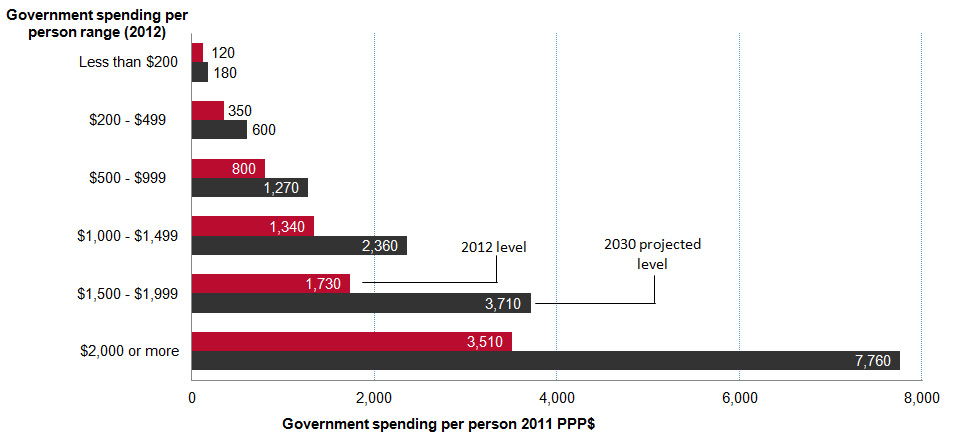Government resources are growing in many developing countries
Government spending in developing countries grew from US$2.4 trillion in 2000 to US$6.4 trillion in 2012 – average growth of 8.6% a year. While China alone accounted for 40% of this growth, more than half of all developing countries experienced annual growth in public spending of 5% or more.
Country progress in growing tax revenues is more mixed. The extent to which revenue growth is based on pro-poor tax regimes is very important for poverty: for example, growth in indirect taxation without exclusions can negatively impact the poorest. Tax avoidance and illicit finance are key issues that require national and supra-national responses.
For many countries where poverty is high, government resources will remain low
Government spending per person is less than PPP$1,500 per person in 58 developing countries, home to 83% of people living in extreme poverty. In 30 countries it is less than PPP$500 per person. This compares with an average PPP$17,485 per person in DAC countries (and PPP$2,170 per person in developing countries as a whole).
Countries with the lowest domestic resources will experience the slowest growth
Countries currently in the lowest spending categories will experience the slowest growth in spending over the period 2015–2030. Without a significant change in course, these countries will face financial constraints to domestically led implementation of the post-2015 agenda. Current projections show that no country where government spending is less than PPP$500 per person will reach PPP$1,000 per person by 2030.
Countries with fast-growing domestic resources will face different challenges
Government spending will grow more rapidly in other countries – for example, it is projected to more than double in Indonesia, the Philippines and Viet Nam, and to almost double in India. The challenges for these countries will be in developing the human and technical capacity, and governance systems, to use resources effectively and scale up service provision.
Figure 2. Government spending per person, 2012 and 2030 projections
Source: Update from ‘Investments to End Poverty’ (2013)
Better data can support effective governance, advocacy and resource allocation
Information on government spending is often partial, out of date and often lacking in detail. Given the centrality of government to the implementation of the post-2015 framework, better data on public spending can benefit many actors, including governments themselves, in allocating resource effectively. For example, data on sub-national spending can help central governments allocate national budgets, as well as donors and civil society working in particular regions. Greater visibility and transparency on public spending can also underpin more effective prioritisation of international resources such as ODA.
